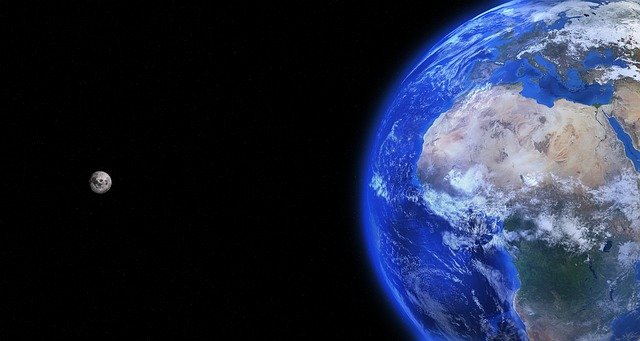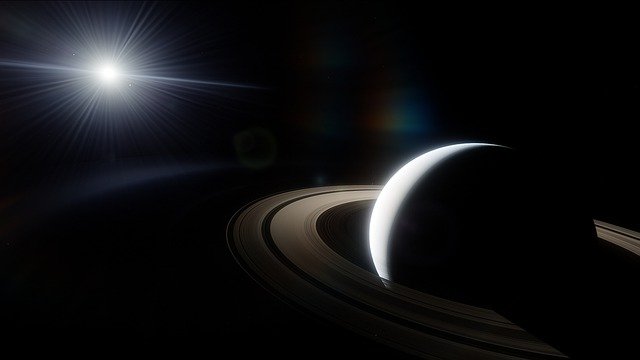*This post may contain affiliate links. This means we may make a commission if you purchase an item using one of our links*
The main differences between Saturn and Earth is that Earth is a terrestrial planet known to harbor intelligent life whilst Saturn is a ringed gas giant that is the 2nd largest planet in our solar system and unlikely to support life. Saturn has 82 moons and is the 6th farthest planet from the Sun whilst Earth is the 3rd farthest planet from the Sun with 1 moon orbiting it.
There are numerous other differences between Earth and Saturn so, continue reading if you want a more detailed look at each planet, their similarities and a more thorough breakdown of their differences.
What Is The Planet Earth?
Table of Contents

Our home planet Earth is the 3rd farthest planet from the Sun, made up of a mixture of water and solid rock like objects, and is the only entity in our solar system known to allow intelligent life forms like ourselves to exist.
Earth’s distance of 152 million km from the Sun has allowed it to remain within the goldilocks zone and as a result, the planet has been able to thrive for millions of years. It orbits the Sun in a circular pattern, much like all the other planets, has only one natural satellite which would be the Moon and is a terrestrial planet to boot.
In regards to its diameter, Earth is the 5th largest planet with a diameter 12,742km.
Earth’s temperature ranges based on the region you’re located where it can be as low as -94 degrees Celsius in Antarctica to as high as 50 – 55 degrees Celsius in Tunisia.
As for the planets composition, it consists of the crust, the mantle, the outer core and the inner core, where the inner core is the hottest element within the Earth reaching temperature in excess of 5,200 degrees Celsius.
In regards to some of its most unique features, Earth is around 71% water, has an atmosphere consisting mostly of oxygen and nitrogen that is also made up of 5 main layers, with the highest to lowest being the troposphere, stratosphere, mesosphere, thermosphere and exosphere.
A day on Earth is 24 hours and an orbital cycle around the Sun takes 365 days to complete. It’s axial tilt is more distinct at 23.5 degrees to the right.
What Is The Planet Saturn?

Saturn is the second largest planet in our solar system, that has a multitude of rings surrounding its gaseous exterior. It’s also the 6th farthest planet from the Sun.
As Saturn falls under the gas giant moniker, the planet is mostly made up of gases. However, Saturn’s composition is a little different from Jupiter’s where its atmosphere is mixture of hydrogen and ices containing elements of Ammonia.
It’s core on the other hand is comprised of a dense core of nickel and iron, which is then surrounded by rocks compressed so strongly that it can tends to reach scorching hot temperatures of 11,700+ degrees Celsius.
On the other hand, It’s gaseous atmosphere is far cooler. The exterior generally sits in the extreme sub zero range where Saturn’s temperatures is -138 degrees Celsius.
This is generally constant throughout the yellow ringed giants day to day. In fact it’s much colder than even the coldest place on Earth, which would be Eastern Antarctic Plateau, Antarctica that hits -94 degrees Celsius, which is more than 40 degrees Celsius warmer.
Being so large (116,460km), Saturn’s gravitational pull is obviously strong. That’s why over it’s 4.5 billion years of existence, beyond its rings this yellow gas giant has managed to accumulate 82 different moons along with other smaller interstellar debris that now orbit it.
In fact it’s largest moon Titan is literally bigger than one of the 8 planets orbiting the Sun, Mercury.
Saturn also orbits the Sun but, as the 6th farthest planet from it, it does mean a singular orbit will take it 29.4 Earth years to complete. In comparison to its axial orbit which only takes 10.7 hours, this is an extremely long time.
Similarities Between Earth And Saturn
Although Saturn and Earth are more different than similar, they still share a few commonalities, which in this case includes the following:
- Both planets orbit the Sun in a circular pattern
- Both have a hotter central core.
- Both are spherical in shape.
- Both have natural satellites orbiting them.
- Both are part of the same solar system.
Differences Between Earth And Saturn
In regards to the differences between Earth and Saturn, they include the following:
- Earth is the 3rd farthest planet from the Sun whilst Saturn is 5th. As a result it takes Earth 365 days to orbit the Sun whilst Saturn completes an orbit in 29.4 years.
- Earth has an axial tilt of 23.5 degrees and Saturn has an axial tilt of 26.73 degrees.
- Saturn is far bigger than Earth where its diameter is 116,460km whereas Earth has a diameter of 12,742km.
- Saturn has 82 moons whilst Earth only has 1.
- A day on Earth takes 24 hours whilst Saturn completes a day in 10.7 hours.
- Earth’s temperature is 13.9 degrees Celsius on whilst Saturn is -138 degrees Celsius.
- Earth has a cooler core where it is 5.200 degrees Celsius whilst Saturn’s core is 11,700 degrees Celsius.
- Saturn is less dense than Earth with a density of 0.687 g/cm³ whereas Earth has a density of 5.51 g/cm³.
- Earth’s gravity is 9.807 m/s² whereas Saturn’s gravity is 10.44 m/s²
- Earth is green and blue whilst Saturn is mostly a pale yellow color.
- Saturn is a gas giant whilst Earth is a terrestrial planet.
- Saturn has 7 rings whilst Earth has 0.
- Earth’s mass is 5.972 × 10^24 kg whilst Saturn’s mass is 5.683 × 10^26 kg.
Summary
Even though Earth and Saturn are part of the same solar system, they are far from similar.
Whether it be their differences in size, temperature, gravity density and general composition. Therefore, it does make a lot of sense why these two have so many different characteristics that separate them form one another..

